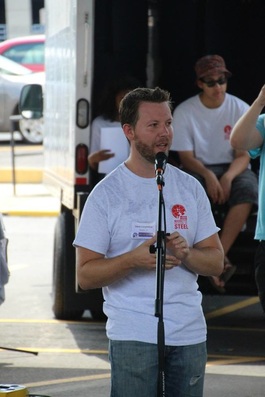
Nelson Madela once said, “Education is the most powerful which you can use to change the world.” If that’s true, there’s no one who can validate that ideal more than Dave Longfellow.
Having grown up playing pan, Longfellow, a native of Morgantown, W.V., was given access to the instrument that only those in Trinidad and Tobago are privy. Even then, not everyone gets to learn from the inventor of the modern steelpan, Ellie Mannette.
From student to teacher, Longfellow has become an example for others to follow, making a career out of teaching, playing, composing/arranging music and organizing events for the steelpan. As the head organizer for the Mannette Festival of Steel and chief organizer for the Virginia Beach International PAN Fest, Longfellow has made a mark on the instrument by making the most of his early education and becoming a champion for the instrument in the United States.
1. How did you get introduced to pan? What do you love most about it?
I was introduced to pan by my middle school band director, a WVU (West Virginia University) percussion graduate named Chip Buck. I always wanted to play drums since elementary school, but Chip insisted I learn a wind instrument first so I could learn how to read music. (Great call, btw!) I was introduced to pan at 10 and it was a perfect match—a melodic instrument that I could hit like a drum!
2. Where did you go to school? Did you study pan there?
I grew up in Morgantown, W.V. and started playing pan at age 10. There was no high school program in town, and there still isn’t one, so I started studying with the WVU Percussion Director, Tim Peterman, at age 11. I then stayed in Morgantown and attended WVU for my undergraduate and graduate degrees in Jazz Studies. The majority of my pan education came from Ellie’s summer workshops in Morgantown, my travels to Trinidad, DC, and Brooklyn, and working with various pan programs throughout the U.S. while in high school and college.
3. What groups do you currently teach and how did those come about? What are the ages of the band members on average?
The Rhythm Project currently has nine different pan ensembles and as director, I oversee all of them. However, I only direct five of the nine, while my Associate Director, Paul Munzenrider, directs the other four. The programs came about via the Virginia Arts Festival’s community engagement initiative when it established itself in the Hampton Roads region of Virginia in 1997. We teach students from eight years old to 18 years old through basically fourth to twelve graders. In 2014-2015 we had 190 students in nine different ensembles.
4. How did the Rhythm Project and its all-star group come to be? About how many performances do the groups do per year combined?
The Rhythm Project started as a year-round educational outreach program of the Virginia Arts Festival. My boss, and now General Manager of VAF, Scott Jackson, started the Rhythm Project in Portsmouth, VA in 1997. In 1999 he hired Anthony Hailey, a WVU graduate, to take over the program as it grew in size. In 2003, Scott hired Ben Meyer, another WVU graduate, as an assistant to Anthony. With enough smaller ensembles established in Portsmouth, Norfolk, Virginia Beach, and Hampton, an “All-Star” ensemble was created as a community high-school ensemble. I was eventually hired in 2008 after Anthony had moved on to start his own program and Ben left to teach in the greater Charleston, S.C. area. The All-Stars perform about 20 times a year while our supporting ensembles have between 2-5 performances a year.
5. What’s been the key to the success of your groups?
Having an intimate knowledge of all the pans in your ensemble combined with a comprehensive understanding of how to arrange for steel bands of varying abilities is extremely helpful. Combine that with strong rehearsal techniques and you can work wonders. I think success with my ensembles comes from an “inside-out” approach. I feel the “rote” method of teaching is as culturally important to pan as the music itself. Teaching the music from the “inside” (i.e. knowing everyone’s part and being able to teach it from memory) instills a sense of confidence and dedication to my students that lets them feel comfortable tackling large chunks of music otherwise unapproachable from staring at it on paper. I think written music is extremely beneficial for pan ensembles, but with most of my ensembles it is used more as a “reference manual” instead of an “instruction manual.”
6. What advice can you give to others who wish to start both school and community steel bands in their region?
I find the hardest problem starting pan programs is the “what comes first” paradigm (i.e. I want to start a pan program because X,Y,Z, but I don’t have any money or pans to prove X,Y,Z.) First off, don’t be afraid to ask for money. “No” is only the second best answer. In addition, ask your friends and colleagues for testimonials for your grant requests. Chances are, if you’re trying to start a pan program, it’s because someone else introduced you to it; use that inspiration to champion your cause! Also, BE FLEXIBLE. If there’s one thing I do know, it’s that almost every single pan program is different. There are so many variables in pan, that you can pretty much guarantee that you will not be able to carbon-copy someone else’s program, and that’s a good thing!
Be willing to build your program around the needs/wants of your school/community. If you come up against resistance, or lack of support in either a school system, or community, try the other option. Chances are, if a school system isn’t interested, the will be opportunities in the community that will be more inviting and visa-versa. Again, be flexible (and PATIENT) and success in one area will create momentum to either continue in that field, or cross over to the other.
7. How did your involvement with the Mannette Festival of Steel come to be? How about the Virginia Beach International Pan Fest?
I started attending the Mannette Workshops at WVU in 1996 and went to every single one of them until they took a break after 2007. By 1997 I was participating in the Faculty Showcase concerts and helping with logistics. After the break in 2008, due to the recession and Kaethe getting sick, Chanler Bailey, Eric Fountain, and I helped Kaethe resurrect the workshop in the summer of 2012. After Kaethe’s untimely passing, I started working with Mannette Musical Instruments to set up a non-profit to take over and start a new festival from scratch, which is what I started in 2013 with their help.
The Virginia International PANFest was already established by the Virginia Arts Festival and started in 2003. It was originally called the PANorama Caribbean Music Festival, but I renamed it in 2014. In 2003 I was directing the WVU steelband and brought them to Virginia Beach as guests of Dr. Ellie Mannette, since he was a judge for the competition, to help get the festival off the ground with outside participants. It was originally started as a showcase festival for the local Rhythm Project ensembles as well as some other local pan groups. Coincidentally, before I started working for the Virginia Arts Festival, I had attended every PANFest.
8. Given your involvement on so many levels of both teaching/running groups and organizing two major pan festivals, what is the most challenging thing out of all of that?
Managing my time and finding new ways to be inspired! The last couple of years have been quite stressful getting to this point. However, now that I have full autonomy over all my endeavors (Rhythm Project, PANFest, Festival of Steel, Clinician), I have been able to find supportive staff to make it all work. With Rhythm Project and PANFest, Paul Munzenrider (another Mannette summer workshop regular) has been an invaluable resource since we hired him last October. With the Festival of Steel, Corey McCormick (WVU world-music student and former Rhythm Project alumni) has stepped-up to help with logistics and to co-produce the event with me. The festival would also not be possible with the great staff I have put together from former Festival of Steel and WVU steelband members over the years. But with all of their help, I feel I’ve been able to not only get the word out about what I do, but they’ve helped me make these events and organizations new staples of the pan community.
9. What impact do these events have on pan in the U.S.?
That’s probably a question you can answer better than I can. My involvement growing up in Morgantown with Ellie has introduced me to some of the most influential people in pan (i.e. builders/tuners, performers, band leaders, educators, organizers, pan jumbies, etc.). The pan world is as big as it is small, and I hope that my network of connections has helped place my programs into the national and international conversations that are pan. My hope is that the Rhythm Project becomes a staple of pan and community engagement in the U.S. As we expand and grow we have also been chronicling our work to help establish a better “pan curriculum” for future generations. As for the PANFest, I hope to make it an International destination for steelband competition. Lastly, of the Festival of Steel, I hope to see it turn into a major, if not THE major, convention for pan in the U.S.. I see the pan presence in PAS and PASIC diminishing, and I feel there is more than enough interest in a convention like that specifically for pan.
10. What percentage of people at the Mannette Festival of Steel are from other countries?
Currently, it is very small. We have had one to two international participants the last three summers. However, I’m looking to raise that number significantly by next summer.
11. When did you take over the Mannette Festival and how has it grown since that time?
I officially took over in 2013. In 2015 we officially registered as a non-profit organization and are currently applying for our 501c3 tax-exempt status. In 2013 we had 30 participants, two faculty, and three staff. This summer we had 83 festival participants, five building workshop participants, five faculty, and 10 staff.
The majority of our participants are new to the festival and have never attended a Mannette workshop/festival before. I look forward to expanding our registration numbers and the scope of the Festival of Steel for 2016!
12. Where do you hope to take it both financially and idealistically in the next five years?
I don’t want to give too much away, but I think our mission statement outlines the vision of the festival quite well.
Our Mission: To celebrate the steelpan by facilitating the exchange of information and ideas through workshops, master classes, lectures, and group performances; bringing together the foremost steel pan artists and educators in the world with a diverse group of steel pan players and enthusiasts; to expose the steel pan community to new works of steelband music and educate participants on the art of steel pan building.
I look forward to carrying out those goals to their fullest extent, which will include adding more ensembles for participants, more artists, guest speakers, sponsors, etc. We received a lot of great feedback after this year’s festival which supports my vision for what I’m trying to accomplish. Although I still have big ideas for the festival, I find that collaboration with the participants and balancing new ideas while listening to feedback has been crucial to the recent success.
13. Where do you see the current state of pan in the U.S.? How can it improve?
I feel that pan in the U.S. is in a very entrepreneurial state right now. When I was growing up, Panyard, Inc., had the U.S. market cornered on mallets, music, newsletters, recordings, etc. and I thought it would be like that for the foreseeable future. But that’s not the case anymore and there’s plenty of room for specialists in all areas of pan. This goes beyond the retail side of things as well. The Festival of Steel and the Virginia International PANFest exist because there’s an obvious need for festivals like these. I know some people are currently trying to get a new U.S. Pan Association together again and that’s a great thing. Heck, kudos to you for putting together the first legit newsletter I’ve seen in almost two decades! So, it seems like the field is wide open right now and people should get out there and take chances—whether it’s starting a new pan program, or starting a pan recording company, pan publishing company, a festival, etc.
HOWEVER, my biggest concern with the pan community in the U.S. is an abysmal lack of builders and tuners. As much as I encourage the pan community to be creative, we need to find ways to convince young people in the community to take a serious interest in building and tuning.
Pan building and tuning is one of the most artisanal crafts I’ve ever witnessed and it needs to be embraced as such. It’s not a hobby—it can’t be—it has to be a career choice. Unfortunately, what I’ve seen recently is a race to get tuning skills and then be a freelance pan tuner. I wish it worked like that, but it does not. And, I feel bad for anyone who was convinced that it would be easy, or too naïve to the reality of the commitment.
Personally, I wouldn’t let anyone without, at least, 10 years of experience tune any of my pans and I don’t think many steelband directors would either. In my experience growing up around Ellie and his apprentices, I’ve learned that the building and tuning craft demands serious commitment. Most pan-men and pan-women get into the art via playing and pick up building/tuning on the side, but all the serious builders have had to make a commitment to the craft in order to do it any justice. There just isn’t enough time to be a professional player AND a professional builder, yet most young builder/tuners can’t make that distinction yet. I don’t know what the answer is, but I don’t think the people realize how dire the situation is becoming—not because we are losing builder/tuners, but because the number of programs is increasing so rapidly that we could drop 10 highly skilled tuners (JUST tuners) into the market right now, and we still wouldn’t have enough to tune all the bands in the country on a regular basis. And, we’re still 10 years away from those 10 tuners being ready, even if they all picked up hammers today…
The Dave Longfellow Ensemble performs “Simple Samba,” written by Dave Longfellow.












